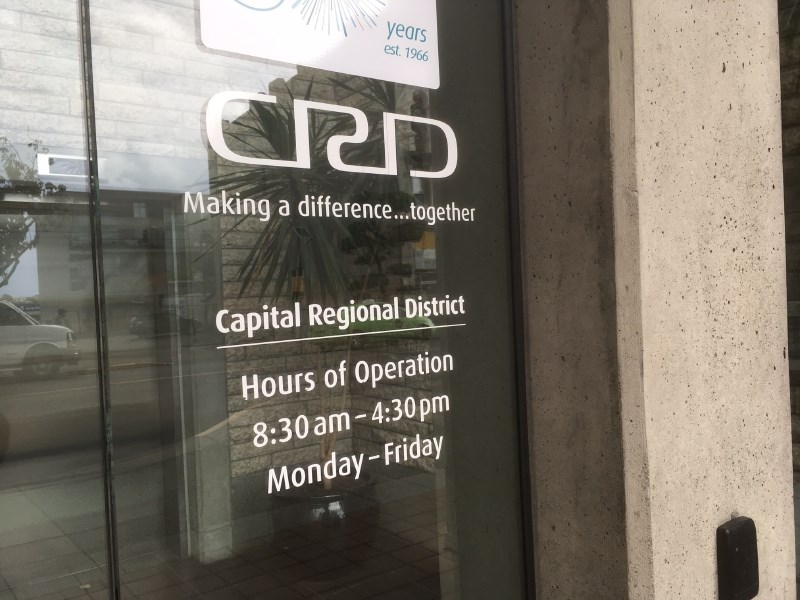Re: “A positive wish for the new year in our region,” comment, Dec. 20.
The comment from mayors Steve Price of Sidney and David Screech of View Royal does a feel-good job of explaining how the Capital Regional District is successful. And to be fair, some aspects of service delivery by the CRD are quite successful, such as regional parks and trails, water supply, the Hartland landfill, recycling and two recent initiatives: the new 911 police dispatch centre and funding community housing.
The mayors confirm that the CRD is not a level of government and has no direct taxing authority. But by mutual agreement, the municipalities can delegate their responsibility to the CRD to deliver shared services.
The CRD collected $220 million in 2016 through municipal tax requisition and user fees (water bills and waste dumping). It has more than 950 employees. If it walks like a duck, sounds like a duck and looks like a duck, it is a duck — that is, a regional government. Except it isn’t given the authority from municipal partners to act like one.
A matrix of the CRD requisition services shows an impressive 110 shared-service delivery contracts. But only 24 are regional scale to nine or more municipalities. More than 85 of them are for service delivery only to small municipalities and unorganized areas. The majority of CRD agenda items deal with these service-delivery responsibilities. The governance model is clearly upside down.
The mayors of Saanich, Victoria, Esquimalt, etc., are compensated for much of their CRD time spent on local matters affecting Highlands, Juan de Fuca, Sooke and Gulf Islands, which comprise less than 15 per cent of the regional population. Not surprisingly, the two mayors who authored the commentary represent smaller municipalities that use the CRD to deliver some of their local services.
While the mayors extol the virtues of how the CRD serves as mechanism for municipalities to co-operate, they conveniently forget to tell how often they don’t act collectively. Several positive initiatives fall short because Langford, Metchosin and Sooke did not join the economic development initiatives; the South Island Prosperity Project, Langford and Colwood are not part of the CRD regional arts service. North Saanich and Sidney are not members of the regional library board.
Nor do the mayors remind us of the sewage-treatment debacle that led to the provincial government intervention on the $750-million project. (Look for your new tax bill this year.)
Another fatal flaw in the structure of the CRD board is the lack of direct accountability. Directors are appointed to the CRD by their local councils, but only after being elected in local elections to, first and foremost, represent and protect interests of their municipality. It is naïve to expect them to serve two masters (local and regional) when they are accountable only to their local electorate.
As a result, each municipal council creates its own fiefdom of local services, e.g. fire department, parks, planning, building inspection, bylaw enforcement and local works. Their 13 land-use official community plans are not required to recognize and deal with major regional issues. Yet we live in region where virtually no one can go anywhere without crossing several jurisdictions en route to work, play, shop or learn, and particularly to the airport, ferries or Inner Harbour. Our current framework for land-use planning fails to deal with use planning in three respects: transportation, housing and urban sprawl.
As for the housing crisis; 13 separate OCPs and more than 400 zoning bylaws and complex development-approval processes block approval of new social and market housing supply.
With no regional transportation authority, we are unable, or at least unwilling, to co-ordinate plans for arterial routes, and fairly share the costs.
And finally, we have the “free rider” problem, where each municipality is responsible to fund its own local services and capital projects. Taxpayers of central-core municipalities must bear the cost of policing, road, new bridges, art and culture facilities that are used by all residents. They also provide tax exemptions to dozens of charitable community and health organizations. At least a third of residents enjoy a daily subsidy as they use these services or facilities and contribute no tax revenue.
Our capacity to respond to major emergencies — oil and chemical spills, large fires, earthquakes — is dangerously fragmented, and residents of small municipalities are actually dependent on professional staff and specialized equipment funded by Victoria, Saanich, the airport and the Department of National Defence.
The remedies are simple but the political will is weak. Three fundamental reforms are necessary: Allow for an elected chair and regional board members; expand the mandate of the regional planning process to include housing and transportation; and continue consolidation of regional emergency services. Unfortunately, those remedies can only be done through provincial leadership.
We suggest that 13 municipalities are too many and that consolidation into five to seven larger municipalities would simplify and improve local governance. Possible mergers of Westshore, Peninsula and core municipalities might be acceptable, and the rural areas could remain apart.
James D. Anderson of Saanich is a member of the Amalgamation Yes board.



